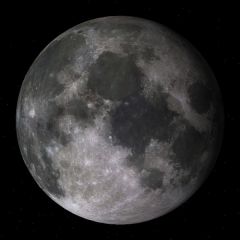Difference between revisions of "Earth spaceports in Orbiter2016"
(Moon) |
(Moon) |
||
| Line 43: | Line 43: | ||
[[Image:MoonScrshot.jpg|thumb|right|Moon in Orbiter]] | [[Image:MoonScrshot.jpg|thumb|right|Moon in Orbiter]] | ||
| − | The Moon is [[Earth]]'s only natural satellite. | + | The Moon is [[Earth]]'s only natural satellite. Its diameter is about one-quarter that of the earth. It is the largest natural satellite as compared to its primary in the solar system and the fifth largest natural satellite in the solar system. It is the only natural body outside of earth that has been visited by humans, the Apollo program from 1969 to 1972. |
| − | == | + | == Characteristics == |
| − | The moon is slightly ellipsoid about 1738 km in radius. | + | The moon is slightly ellipsoid about 1738 km in radius. The radius of the moon is about a quarter that of the Earth. Because it is far away it looks small, about half a degree wide. The gravity on the moon is 1.625 m/s<sup2</sup>, about one-sixth of the Earth's gravity, therefore, an object on the moon's surface will weigh about one-sixth as it does on the earth. The surface of the moon consists of rock and dusty regolith, and is comprised of maria, craters, mountains, rifts, and scarps. Surface temperatures range from -171°C (-276°F) during the lunar night to 140°C (284°F) during the lunar day, the surface receives a high amount of ionizing radiation from the sun as well as cosmic radiation. |
| − | The | + | The orbit of the moon is inclined to the ecliptic at about 5°, the only natural in the solar system to do so, the others are inclined to the primary's equator). The moon's rotational axis tilted from the ecliptic about 1.5°. The semi-major axis is about 380000 km |
| + | |||
| + | As the moon is tidally locked to the earth, the same side always faces the earth, except some variation due to libration, from the earth, we are able to see about 59% of the moon's surface over time. The apparent diameter of the moon from the earth's surface is about one-half degree, about the same as that of the sun, so, during solar eclipses, the moon may pass slightly north or south of the center of the sun creating a partial eclipse, or pass close to apoapsis creating an annular eclipse, or covering the entire sun, creating a total eclipse. The sidereal day on the moon is about 27.33 earth days | ||
| + | |||
| + | |||
| + | |||
| + | |||
| + | |||
| + | The Moon moves slowly away from the earth at a rate of 3.8cm per year, due to the effect of tidal dissipation. | ||
== See also == | == See also == | ||
Revision as of 12:19, 17 June 2021
The Moon is Earth's only natural satellite. Its diameter is about one-quarter that of the earth. It is the largest natural satellite as compared to its primary in the solar system and the fifth largest natural satellite in the solar system. It is the only natural body outside of earth that has been visited by humans, the Apollo program from 1969 to 1972.
Characteristics
The moon is slightly ellipsoid about 1738 km in radius. The radius of the moon is about a quarter that of the Earth. Because it is far away it looks small, about half a degree wide. The gravity on the moon is 1.625 m/s<sup2, about one-sixth of the Earth's gravity, therefore, an object on the moon's surface will weigh about one-sixth as it does on the earth. The surface of the moon consists of rock and dusty regolith, and is comprised of maria, craters, mountains, rifts, and scarps. Surface temperatures range from -171°C (-276°F) during the lunar night to 140°C (284°F) during the lunar day, the surface receives a high amount of ionizing radiation from the sun as well as cosmic radiation.
The orbit of the moon is inclined to the ecliptic at about 5°, the only natural in the solar system to do so, the others are inclined to the primary's equator). The moon's rotational axis tilted from the ecliptic about 1.5°. The semi-major axis is about 380000 km
As the moon is tidally locked to the earth, the same side always faces the earth, except some variation due to libration, from the earth, we are able to see about 59% of the moon's surface over time. The apparent diameter of the moon from the earth's surface is about one-half degree, about the same as that of the sun, so, during solar eclipses, the moon may pass slightly north or south of the center of the sun creating a partial eclipse, or pass close to apoapsis creating an annular eclipse, or covering the entire sun, creating a total eclipse. The sidereal day on the moon is about 27.33 earth days
The Moon moves slowly away from the earth at a rate of 3.8cm per year, due to the effect of tidal dissipation.
See also
Moon in Wikipedia. Category: Add-ons for Moon
see also: Wikipedia [1]
 | This natural satellite related article is a stub. You can help Orbiterwiki by expanding it. |

